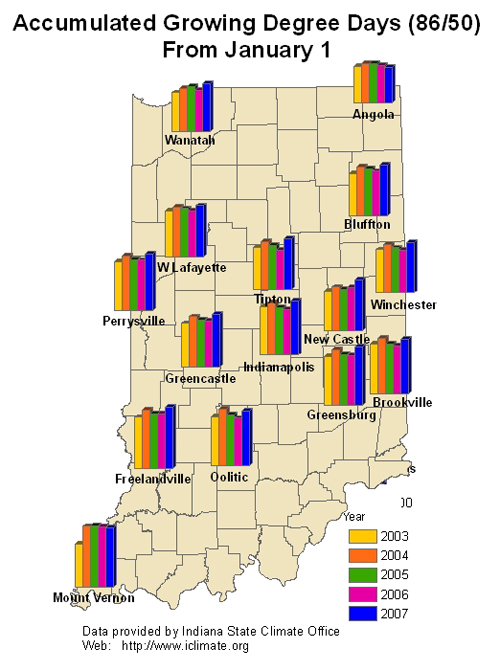Pest & Crop Newsletter, Entomology Extension, Purdue University
- Droughty Corn: Should Rootworm Beetles Be Treated For Leaf Feeding, Will They Wipe Out The Silks
- What is That Gigantic Beetle!?!?
- Black Light Trap Catch Report
- Assessing Effects of Drought on Corn Grain Yield?
- A Fast & Accurate Pregnancy Test for Corn
- Grain Fill Stages in Corn
![]()
Droughty Corn: Should Rootworm Beetles Be Treated For Leaf Feeding, Will They Wipe Out The Silks? - (Christian Krupke, John Obermeyer, and Larry Bledsoe)
- Beetle leaf feeding quite showy in some drought stressed corn.
- Impact of leaf feeding on yield is expected to be minimal.
- Beetles, if still present, will move to pollen and silk feeding.
- Uneven pollination complicates treatment decisions.
Before pollination, western corn rootworm beetles (especially males) have emerged and will feed on the green tissue of the leaves. Leaves may be partially or totally stripped by adults, resulting in a parchment-like appearance to the damaged area. Surprisingly, some have misdiagnosed this showy damage as either flea beetle feeding or anthracnose leaf disease. Admittedly, the leaf feeding is more apparent in fields than normal, especially those under drought stress. Now the question, should beetles be treated for this leaf feeding, especially with anticipation of silk feeding?

Heavy rootworm adult feeding on susceptible inbred lines of corn
In a “normal” year, we discount this leaf feeding as cosmetic or non-economic. This is partially because the time period between beetle emergence and plant pollination is so short that leaf feeding is minimized before the beetles switch to their favorite food…pollen. In fact, beetles cannot survive in the lab when fed a diet composed exclusively of corn leaves. Refer to the Corn & Soybean Field Guide (2007 edition), pages 31 to 33 to help assess the potential economic impact of this feeding. Page 31 has a diagram depicting various percentages of leaf area injury, use this when viewing green leaves and determining the percentage of WHOLE plant feeding injury. Pages 32 and 33 display a table adapted from the National Crop Insurance on yield loss due to hail defoliation at various corn stages. Hail is a one-time event while beetles feed over time, but both result in loss of leaf tissue, or photosynthetic area. In general, the older the plant, the less important the leaves become. For example, when looking at pre-tassel corn on the table, it requires 10% leaf defoliation to sustain a 3% yield loss (.03 X 150 yield = 4.5 bu/A). From fields we have seen and pictures sent to us, nothing comes even close to 10% whole plant defoliation. Some keen observers have noted a distinct difference in leaf feeding by variety. This is probably due to the levels of lignin and other anti-feeding compounds that are present in a given variety. The bottom line – leaves are not worth worrying about, even in these dry conditions.
 Watch a short video of the western corn rootworm beetles feeding on corn leaves.
Watch a short video of the western corn rootworm beetles feeding on corn leaves.
Treating for beetles feeding on drought stressed corn will NOT suddenly turn it around the yield potential. You may want to refer to this week’s Agronomy Tips article by Bob Nielsen, “Assessing Effects of Drought on Corn Grain Yield?” On the other hand, protection of silks may be necessary should these beetles remain abundant in the field while plants attempt to pollinate. Only ½” of silk is required for successful pollination. Note that silks do grow back after feeding, and can withstand heavy pressure. Major considerations are spotty pollination within fields by soil types and tassel and silk emergence out of sequence. Keep in mind that fields will probably have to be sprayed with high-clearance rigs, as aerial applicators are quite busy with the pre-booked, prophylactic fungicide treatments. Remember that the residual of insecticides will be 7 days at most. This provides a “window”, but is not long enough for fields pollinating over an extended period. Rootworm beetles are very mobile and willing and able to move to areas with fresh pollen. Happy scouting.

Attention getting rootworm beetle feeding (Photo credit: Brian Warren, Frick Services)
![]()
What is That Gigantic Beetle!?!? – (Christian Krupke and John Obermeyer)
Several inquiries have been received about “huge” Japanese-like beetles seen around farmsteads. No, a mutation of the Japanese beetle has not occurred but rather another related scarab, the green June beetle, has been seen with more frequency this year.
The large, iridescent, green June beetle feed on many plants, as do the Japanese beetle, but they are especially fond of ripe fruit. Ripening peaches, berries, plums, etc. may be subject to clusters of these pests. The beetles may (very) occasionally feed on corn, but significant damage has not been reported. The green June beetle grub, as with the Japanese beetle grub, feed-on decaying matter and grass roots in the soil. However, the green June beetle larva is much larger and creates tunnels as they move about in the soil. These tunnels can significantly disrupt turf and grass pastures.
Bottom-line, be alert to these “pretty” beetles attempting to cut into your fruit harvest.

Green June beetle and Japanese beetle
![]()
Click here to view the
Black Light Trap Catch Report - (John Obermeyer)
![]()
Corn Disease Update - (Greg Shaner)
- There is very little leaf disease on corn.
Despite the recent muggy weather, I have seen very little leaf disease on corn in my travels around the state. Many other people are reporting the same lack of disease. I have seen a few of what are probably young lesions of gray leaf spot in no-till fields of second-year corn. There are low levels of rust in some fields, but it does not appear to be increasing rapidly. Most fields are clean. Corn in many fields is now silking. Even if leaf blights begin to develop now, it will take some time for substantial amounts of leaf tissue to be destroyed. The further along corn is before disease develops, the less likely there is to be much reduction in yield. Growers who have elected to spray fields with fungicides this year should monitor both unsprayed and sprayed portions of fields to determine how much disease actually develops and to what extent treatment provides control. This will greatly help when it comes time to interpret yield data.
![]()
Soybean Downy Mildew – (Gregory Shaner)
- Disease is present in central Indiana.
I saw two fields on July 10 that had a moderate severity of downy mildew. Downy mildew is caused by a fungus-like organism, Peronospora manshurica. Infected plants have pale green to bright yellow spots on the upper surface of the leaf. On the lower leaf surface, the lesion is darker and covered with a fine tuft of sporangiophores and spores when air is humid. These airborne spores can cause additional infection on young leaves. Older lesions may not produce spores. The pathogen survives between seasons as spores on leaf residue or on seed. Spores on seed may systemically infect the young plant as the seed germinates. Downy mildew usually does not reduce yield. Fungicides commonly used on soybean do not include downy mildew as a target disease.

Downy mildew lesions on leaves

Assessing Effects of Drought on Corn Grain Yield? - (Bob Nielsen)
Parts of Indiana remain abnormally dry as we approach the middle of the growing season for corn; especially the eastern areas of the state. Nearly 80% of Indiana was classified as abnormally dry while 32% of the state was classified as experiencing moderate drought conditions as of 10 July according to the U.S. Drought Monitor Web site (Fig. 1). Rains throughout the state during the past week have actually moderated the drought ratings somewhat compared to recent weeks; which is also reflected by the slight improvement in USDA estimates of Indiana’s corn crop condition as of 1 July (Fig. 2).

Fig. 1. Estimates of drought conditions throughout Indiana as of 10 July 2007. Source: US Drought Monitor, <http://drought.unl.edu/dm>.
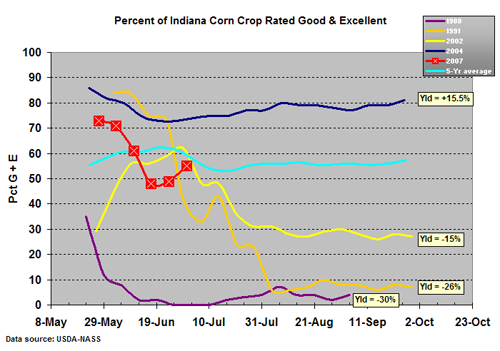
Fig. 2. Percent of Indiana corn crop rated good & excellent from late May through early July for 2007 versus several other years and the 5-year average. the yield values shown in the yellow boxes indicate the percent above or below Indiana corn trend yield for each indicated year. Source: USDA-NASS, 2007.
Estimates of soil moisture deficits by the Midwest Regional Climate Center (10 July 2007) mirror the estimates of drought conditions. As of 10 July, estimates of soil moisture in the upper 72 inches throughout most of the eastern half of Indiana ranged from 5 to 120% below normal (Fig. 3). Estimates of soil moisture in the upper 12 inches indicate that areas of northeast Indiana were as great as 30% below normal as of 10 July (Fig. 4).
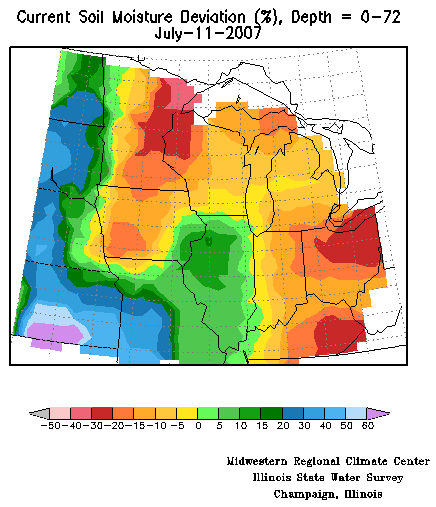
Fig. 3. Estimate of soil moisture deficits throughout the U.S. Midwest in the upper 72 inches as of 10 July 2007. Source of image: Midwestern Regional Climate Center, <http://mcc.sws.uiuc.edu/cliwatch/watch.htm>.
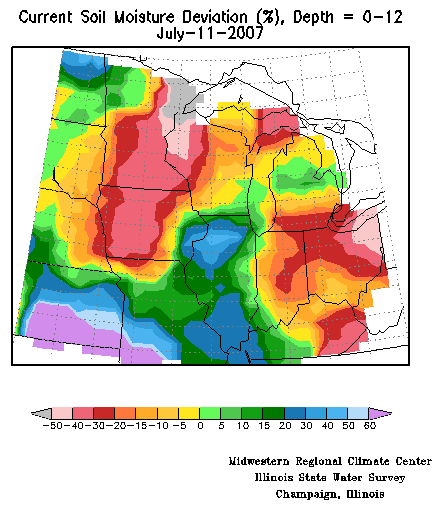
Fig. 4. Estimate of soil moisture deficits throughout the U.S. Midwest in the upper 12 inches as of 10 July 2007. Source of image: Midwestern Regional Climate Center, <http://mcc.sws.uiuc.edu/cliwatch/watch.htm>.
Obviously, none of this is any surprise to those growers affected by dry soils this current growing season. The nagging question that continues to be debated at the corner table of the Chat ‘n Chew Café is how much yield potential has been or will be lost due to these dry soils and hot temperatures?
Unfortunately, accurately predicting the effects of severe drought stress on corn grain yield is never easy or straightforward. The actual yield for any given field is determined cumulatively throughout the entire season; not at any specific point in time. Like any stress, the effects of drought on corn grain yield depend on the severity of the stress, the duration of the stress, and the timing of the stress with crop developmental stages.
Grain yield can be broken down into several components, each of which is determined or “set” at different periods throughout the growing season (Fig. 5). The potential number of productive plants per acre is determined during the first 30 to 45 days after planting (germination through about leaf stage V6). Severe stress throughout the growing season can continue to affect harvestable plant population until harvest is complete.
The potential size of the ear (number of ovules) is determined over a lengthy period ranging from about leaf stage V5 to maybe as late as V15 (Nielsen, 2007b). The success or failure of pollination determines what percentage of the number of ovules will be fertilized and thus initiate kernel development (Nielsen, 2007a). The actual number of surviving kernels is largely determined during the first week or two following pollination (Nielsen, 2005). Finally, dry weight per kernel is determined throughout the remainder of the so-called “grain fill” period (Nielsen, 2007c) that terminates with the development of the kernel black layer (aka physiological maturity).
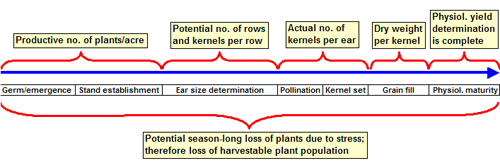
Fig. 5. An illustration of the timing of yield component determination in corn.
Given the early beginning of drought or near-drought conditions this year in Indiana, essentially every single yield component may be influenced in some fields. Stand establishment in 2007 was erratic or non-existent due to excessively dry seedbeds in some areas of the state (Nielsen, 2007f). Consequently, the productive number of plants per acre was significantly reduced from the “git-go”.
Ear size determination was undoubtedly impeded in some fields due to severe drought stress from V5 to V15. Dryness that caused leaf rolling only in the afternoon hours is probably not severe enough to significantly reduce ear size determination. Leaf rolling that occurred from shortly after sun-up to after dusk probably constitutes severe drought stress. Leaf and/or plant death due to drought obviously constitutes severe drought stress.
The success of pollination and the grain fill period this current season largely remains to be seen as of the date that I’m writing this article. Traditionally, the pollination phase is referenced as THE most important yield-determining period of the growing season relative to the percent of yield potential that can be lost per day of severe stress (Thelen, 2007). When coupled with the importance of the first couple of weeks following pollination that determines “kernel set” (Nielsen, 2004b), there is no question that the next few weeks will be very important in determining the severity of yield loss due to drought this year.
Estimating actual or percent yield loss due to drought is challenging for the reasons I’ve outlined above. Obviously, one can estimate yield potential due to a lower productive plant population by using available references on yield and plant population (Nielsen, 2007f). Assessing ear size potential prior to pollination is difficult to do because of the small size of the developing cobs (Nielsen, 2007b). Assessing the success of pollination can be done shortly after pollination is complete by conducting the so-called “ear shake” test (Nielsen, 2007a).
The first opportunity to integrate most of the yield components into a pre-harvest estimate of grain yield occurs by dough stage of kernel development or later when one can count the likely number of harvestable ears per acre and the average number of kernels per ear (Nielsen, 2004a). This so-called “yield component” method for estimating grain yield will place you in the proverbial “ball park” for accuracy, but can vary plus or minus 20 bushels per acre in my experience. This method for estimating grain yield is not precise because kernel dry weight (the final yield component) cannot be estimated prior to physiological maturity and so the formula uses a proverbial “fudge factor” for kernel weight in order to complete the yield estimate.
Bottom line…………This year’s drought conditions will undoubtedly result in lower than desired corn grain yields for some growers; the magnitude of which is nearly impossible to estimate with any degree of accuracy at this point in time.
Related References
Midwest Regional Climate Center. 2007. Midwest Climate Watch. [On-Line]. Available at <http://mcc.sws.uiuc.edu/cliwatch/watch.htm>. (URL verified 7/5/07).
Nafziger, Emerson. 2007. How Soon and How Much Does It Need to Rain? Illinois Pest & Crop Bulletin. Univ. of Illinois. [On-Line]. Available at <http://www.ipm.uiuc.edu/bulletin/article.php?id=782>. (URL verified 7/5/07).
Nielsen, R.L. (Bob). 2004a. Estimating Corn Grain Yield Prior to Harvest. Corny News Network, Purdue Univ. [On-Line]. Available at <http://www.kingcorn.org/news/articles.04/YieldEst-0718.html>. (URL verified 7/4/07).
Nielsen, R.L. (Bob). 2004b. Yield Loss Potential During Grain Fill. Corny News Network, Purdue Univ. [On-Line]. Available at <http://www.kingcorn.org/news/articles.04/GrainFillStress-0705.html>. (URL verified 7/4/07).
Nielsen, R.L. (Bob). 2005. Kernel Set Scuttlebutt. Corny News Network, Purdue Univ. [On-Line]. Available at <http://www.kingcorn.org/news/articles.05/KernelSet-0809.html>. (URL verified 7/4/07).
Nielsen, R.L. (Bob). 2007a. A Fast & Accurate Pregnancy Test for Corn. Corny News Network, Purdue Univ. [On-Line]. Available at <http://www.kingcorn.org/news/timeless/EarShake.html>. (URL verified 7/2/07).
Nielsen, R.L. (Bob). 2007b. Ear Size Determination in Corn. Corny News Network, Purdue Univ. [On-Line]. Available at <http://www.kingcorn.org/news/timeless/EarSize.html>. (URL verified 7/5/07).
Nielsen, R.L. (Bob). 2007c. Grain Fill Stages in Corn. Corny News Network, Purdue Univ. [On-Line]. Available at <http://www.kingcorn.org/news/timeless/GrainFill.html>. (URL verified 7/2/07).
Nielsen, R.L. (Bob). 2007d. Silk Emergence. Corny News Network, Purdue Univ. [On-Line]. Available at <http://www.kingcorn.org/news/timeless/Silks.html>. (URL verified 7/2/07).
Nielsen, R.L. (Bob). 2007e. Tassel Emergence & Pollen Shed. Corny News Network, Purdue Univ. [On-Line]. Available at <http://www.kingcorn.org/news/timeless/Tassels.html>. (URL verified 7/2/07).
Nielsen, R.L. (Bob). 2007f. Variable Emergence Due to Variable Seedbed Moisture. Corny News Network, Purdue Univ. [On-Line]. Available at <http://www.kingcorn.org/news/articles.07/VariableEmergence-0520.html>. (URL verified 7/5/07).
Thelen, Kurt. 2007. Assessing drought stress effects on corn yield. Field Crop Advisory Team Alert Newsletter. Michigan State Univ. [On-Line]. Available at <http://www.ipm.msu.edu/cat07field/fc06-28-07.htm>. (URL verified 7/5/07).
Thomison, Peter. 2007. Drought and Heat Stressing Corn. C.O.R.N. Newsletter, Ohio State Univ. [On-Line]. Available at <http://agcrops.osu.edu/story.php?setissueID=189&storyID=1134>. (URL verified 7/5/07).
USDA-NASS. 2 July 2007. Indiana Crop & Weather Report. USDA-Nat’l Ag Statistics Service. Vol. 57, No. 26. [On-Line]. Available at <http://www.nass.usda.gov/Statistics_by_State/Indiana/Publications/
Crop_Progress_&_Condition/2007/we2607.pdf>. (URL verified 7/2/07).
U.S. Drought Monitor. 2007. [On-Line]. Available at <http://www.drought.unl.edu/dm/monitor.html>. (URL verified 7/3/07).
![]()
A Fast & Accurate Pregnancy Test for Corn - (Bob Nielsen)
- Silk clipping by insects can interfere with pollination success.
- Silks normally detach from fertilized ovules within days of successful pollination and thus can be used as an early indicator of pollination progress and/or success.
Silk clipping by corn rootworm beetles, Japanese beetles, and other obnoxious critters during pollination can be severe enough to impede pollen capture and germination. While you may be tempted to apply insecticides at the first sign of these insects, Purdue entomologists tell us that treatment is not necessary unless the silks are being continuously clipped back to less than 1/2 inch long before pollination is 50 percent complete (Krupke et. al., 2007). Silk length is easy to measure, but how do you determine the progress of pollination?
Obviously, one could wait impatiently until kernel development was visibly apparent. Within about 10 to 14 days after pollen shed, developing kernels will resemble white blisters on the cob (Nielsen, 2007a). Unfortunately, by then any insect interference with the pollination process will have already taken its toll on kernel set. Luckily for us, the corn plant exhibits an earlier indicator of pollination progress.
Silk Detachment From Fertilized Ovules
Remember that each ovule (potential kernel) on the ear develops a silk (the functional “style” of the female flower) that elongates and eventually emerges through the ear’s husk leaves the tip of the ear shoot (Nielsen, 2007b). The silks represent the “pathway” for the male gametes in the pollen to fertilize the female gametes in the ovules.
Once a pollen grain is “captured” by a trichome or “hair” of a silk, the pollen grain germinates and develops a pollen tube that contains the male genetic material. The pollen tube penetrates the silk and, with adequate moisture and temperature, elongates down the length of the silk within 24 hours and fertilizes the ovule.
Within 2 to 3 days after an ovule has been successfully fertilized, the base of the silk will collapse and detach from the immature kernel. The kernel itself will usually not be recognizable to the naked eye at this stage. Silks of nonfertilized ovules remain attached, however, and will continue to lengthen and be receptive to pollen for up to 10 days after emergence from the ear shoot. Even if never fertilized, silks will remain attached to the ovules. Within days of full silk emergence, therefore, pollination progress may be estimated on individual ears by estimating percent silk detachment.

Silks (styles) attached to ovules on ear shoot.

Silks emerging from husk leaves of ear shoot.

Pollen grains captured on trichomes or "hairs" of silks

Closeup of attached vs. detached silks.
The Ear Shake Technique
For each ear, make a single lengthwise cut from the base of the ear shoot to the tip with a sharp knife, through the husk leaves to the cob. Slowly unwrap the husk leaves, taking care not to rip any silks from the ovules yourself. Then gently shake the ear. Silks of fertilized ovules will drop away; silks from unfertilized ovules will remain attached.
With practice, pollination progress can be easily determined by estimating the percentage of silks that fall away from the cob. Sampling several ears at random throughout a field will provide an indication of the progress of pollination for the whole field.

Ear with few detached silks, indicating little ovule fertilization.
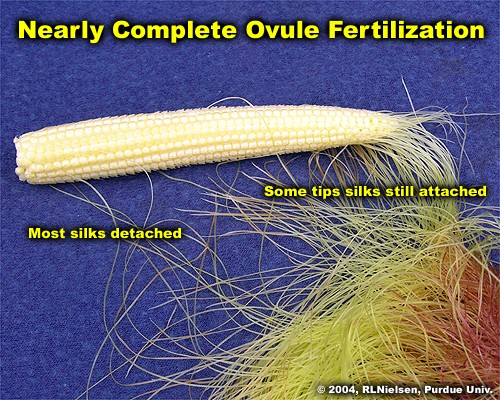
Ear with majority of silks detached, incidating nearly complete ovule fertilization.
One Last Comment
While the “ear shake” technique helps you estimate pollination progress with respect to ovule fertilization, remember that pollination progress includes pollen shed progress. Check the tassels in early to mid-morning hours to determine whether anther exsertion and pollen shed are still occurring.
Remember, that anther exsertion and pollen shed typically begin on the central tassel stalk, then spreads progressively throughout the tassel branches (Nielsen, 2007c). If no further pollen shed is likely to occur, it doesn’t matter how badly those nasty insects are clipping silks. Unfertilized ovules will remain unfertilized ovules if there is no pollen left in the field. Spraying the bejeebers out of a field at that point is simply a costly form of revenge!
Related References
Krupke, Christian H., Larry W. Bledsoe, and John L. Obermeyer. 2007. Managing Corn Rootworms - 2007. Purdue Univ. Coop. Ext. Service Pub. No. E-49-W. [On-Line]. Available at <http://www.entm.purdue.edu/Entomology/ext/targets/e-series/EseriesPDF/E-49.pdf>. (URL verified 7/2/07).
Nielsen, R.L. (Bob). 2007a. Grain Fill Stages in Corn. Corny News Network, Purdue Univ. [On-Line]. Available at <http://www.kingcorn.org/news/timeless/GrainFill.html>.(URL verified 7/2/07).
Nielsen, R.L. (Bob). 2007b. Silk Emergence. Corny News Network, Purdue Univ. [On-Line]. Available at <http://www.kingcorn.org/news/timeless/Silks.html>. (URL verified 7/2/07).
Nielsen, R.L. (Bob). 2007c. Tassel Emergence & Pollen Shed. Corny News Network, Purdue Univ.
[On-Line]. Available at <http://www.kingcorn.org/news/timeless/Tassels.html>. (URL verified 7/2/07).
![]()
Grain Fill Stages in Corn - (Bob Nielsen)
The grain fill period begins with successful pollination and initiation of kernel development, and ends approximately 60 days later when the kernels are physiologically mature. During grain fill, the developing kernels will be the primary sink for concurrent photosynthate produced by the corn plant.
What this means is that the photosynthate demands of the developing kernels will take precedence over that of much of the rest of the plant. In essence, the plant will do all it can to “pump” dry matter into the kernels, sometimes at the expense of the health and maintenance of other plant parts including the roots and lower stalk. A stress-free grain fill period can maximize the yield potential of a crop, while severe stress during grain fill can cause kernel abortion and lightweight grain, and encourage the development of stalk rot.
Kernel development proceeds through several relatively distinct stages (Ritchie et. al., 1993).
Silking Stage (Growth Stage R1)
Some may argue whether silking should be labeled as a kernel growth stage, but nonetheless silk emergence is technically the first identifiable stage of the reproductive period. Silks remain receptive to pollen grain germination up to 10 days after silk emergence (Nielsen, 2007a). Silk receptivity decreases rapidly after 10 days if pollination has not yet occurred. Natural senescence of silk tissue over time results in collapsed tissue that restricts continued growth of the pollen tube. Silk emergence usually occurs in close synchrony with pollen shed (Nielsen, 2007b), so that duration of silk receptivity is normally not a concern. Failure of silks to emerge in the first place (for example, in response to silkballing or severe drought stress) does not bode well for successful pollination.

Initial emergence of silks from husks of ear shoot (growth stage R1).
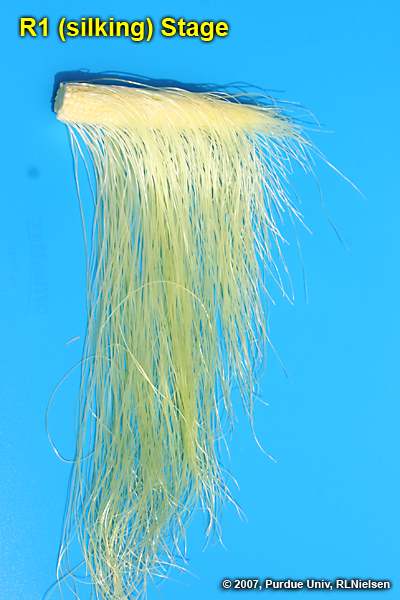
Appearance of cob and silks at growth stage R1.
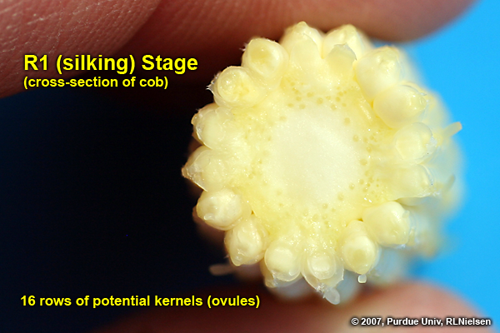
Cross-section of cob at growth stage R1.
Kernel Blister Stage (Growth Stage R2)
About 10 to 14 days after silking, the developing kernels are whitish “blisters” on the cob and contain abundant clear fluid. The ear silks are mostly brown and drying rapidly. Some starch is beginning to accumulate in the endosperm. The radicle root, coleoptile, and first embryonic leaf have formed in the embryo by the blister stage. Severe stress can easily abort kernels at pre-blister and blister stages. Kernel moisture content is approximately 85 percent.


Kernel Milk Stage (R3)
About 18 to 22 days after silking, the kernels are mostly yellow and contain “milky” white fluid. The milk stage of development is the infamous “roasting ear” stage, that stage where you will find die-hard corn aficionados standing out in their field nibbling on these delectable morsels. Starch continues to accumulate in the endosperm. Endosperm cell division is nearly complete and continued growth is mostly due to cell expansion and starch accumulation. Severe stress can still abort kernels, although not as easily as at the blister stage. Kernel moisture content is approximately 80 percent.
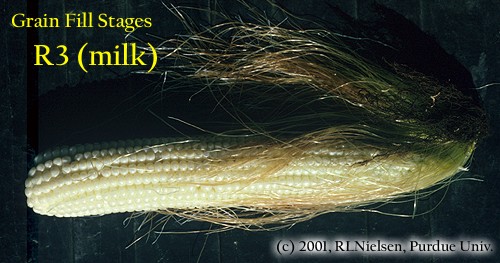
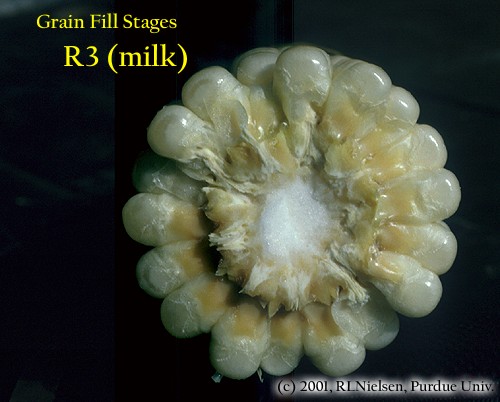
Kernel Dough Stage (R4)
About 24 to 28 days after silking, the kernel’s milky inner fluid is changing to a “doughy” consistency as starch accumulation continues in the endosperm. The shelled cob is now light red or pink. By dough stage, four embryonic leaves have formed and about 1/2 of the mature kernel dry weight is now in place. Kernel abortion is much less likely once kernels have reached early dough stage, but severe stress can continue to affect eventual yield by reducing kernel weight. Kernel moisture content is approximately 70 percent.
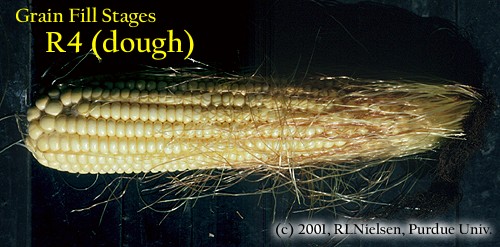
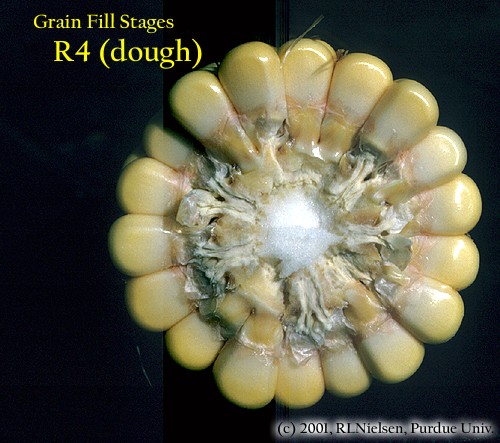
Kernel Dent Stage (R5)
About 35 to 42 days after silking, all or nearly all of the kernels are denting near their crowns. The fifth (and last) embryonic leaf and lateral seminal roots form just prior to the dent stage. A distinct horizontal line appears near the dent end of the kernel and slowly progresses to the tip end of the kernel over the next 3 weeks or so. This line is called the “milk line” and marks the boundary between the liquid (milky) and solid (starchy) areas of the maturing kernels. Severe stress can continue to limit kernel dry weight accumulation. Kernel moisture content at the beginning of the dent stage is approximately 55 percent.
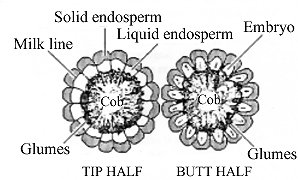

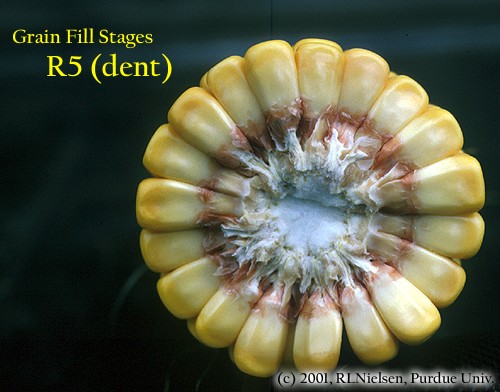
Physiological Maturity (R6)
About 55 to 65 days after silking, kernel dry weight usually reaches its maximum and kernels are said to be physiologically mature and safe from frost. Physiological maturity occurs shortly after the kernel milk line disappears and just before the kernel black layer forms at the tip of the kernels. Severe stress after physiological maturity has little effect on grain yield, unless the integrity of the stalk or ear is compromised (e.g., damage from European corn borer or stalk rots). Kernel moisture content at physiological maturity averages 30 percent, but can vary from 25 to 40 percent grain moisture.


Harvest Maturity
While not strictly a stage of grain development, harvest maturity is often defined as that grain moisture content where harvest can occur with minimal kernel damage and mechanical harvest loss. Harvest maturity is usually considered to be near 25 percent grain moisture.
Related References
Nielsen, R.L. (Bob). 2004. Yield Loss Potential During Grain Fill. Corny News Network, Purdue Univ. [On-Line]. Available at <http://www.kingcorn.org/news/articles.04/GrainFillStress-0705.html>. (URL verified 7/4/07).
Nielsen, R.L. (Bob). 2005. Kernel Set Scuttlebutt. Corny News Network, Purdue Univ. [On-Line]. Available at <http://www.kingcorn.org/news/articles.05/KernelSet-0809.html>. (URL verified 7/4/07).
Nielsen, R.L. (Bob). 2007a. Silk Emergence. Corny News Network, Purdue Univ. [On-Line]. Available at <http://www.kingcorn.org/news/timeless/Silks.html>. (URL verified 7/2/07).
Nielsen, R.L. (Bob). 2007b. Tassel Emergence & Pollen Shed. Corny News Network, Purdue Univ.
[On-Line]. Available at <http://www.kingcorn.org/news/timeless/Tassels.html>.(URL verified 7/2/07).
Ritchie, S.W., J.J. Hanway, and G.O. Benson. 1993. How a Corn Plant Develops. Iowa State Univ. Sp. Rpt. No. 48. [On-Line]. Available at <http://www.extension.iastate.edu/pages/
hancock/agriculture/corn/
corn_develop/CornPlantStages.html>. (URL verified 7/2/07).


